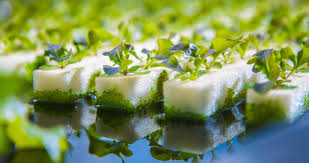Hydroponic nutrients are an important part of your hydroponics system. They provide plants with the essential elements they need to thrive, as well as help improve the health of your soil.
A nutrient solution is a blend of water and fertilizer that provides plants with all the necessary elements they need to thrive in a hydroponic environment. These nutrient solutions contain macronutrients, such as nitrogen and phosphorus, as well as micronutrients, such as potassium and calcium.
Depending on your plant type, your hydroponic nutrient solutions should have a pH level of between 5.5 and 6.3. The correct pH level ensures that all the nutrients are absorbed into your hydroponic plants.
If your nutrient solution has a pH level higher than 6.5, it can cause problems with the absorption of certain nutrients. For example, calcium and magnesium are absorbed more slowly when the pH is above 6.5. Iron and copper are also absorbed at a much slower rate when the pH is over 6.5.
In order to avoid these problems, make sure that your nutrient solution is of the correct pH level before adding it to your hydroponic water. You can check your hydroponic nutrient solution’s pH level by using a pH meter.
Another way to check the pH level is by observing how the plants grow. Some plants, such as tomatoes, require a more acidic pH level than others. Regardless of your plant type, you should check the pH level before adding a new nutrient.
It is also a good idea to keep track of the electrical conductivity (EC) of your hydroponic nutrient solution. This will allow you to check how concentrated it is, so that you don’t overfeed your plants.
When it comes to diy hydroponic nutrients mixes, there are several different types to choose from. Each one can be made in a variety of ways, and it’s up to you to decide which mix is right for you and your plants.
First, you’ll need to determine the weight of your nutrient salts. This will be based on the amount of water they can absorb, so you’ll want to use a mix that can handle the volume you’re growing in your hydroponic system.
Once you’ve determined the weight of your nutrient salts, you can start to add them to your water. You’ll want to use a liquid-based nutrient solution for this, so you can mix it easily.
Your hydroponic nutrient mixture should be at a concentration of about 10 parts per million (PPM). This is a measure of the total dissolved solids in the water, and it’s a good idea to use an EC meter to check the concentration of your homemade hydroponic nutrient mix several times.
In addition, you’ll need to consider the strength of the nutrient mixture, as some plants require stronger solutions than others. This will depend on your plants and the stage of growth you’re in.
For the best results, try mixing your nutrient mixtures with a ratio of around 10 parts water to 1 part nutrient salts. This will ensure that your hydroponic nutrient solution is concentrated enough to keep your plants healthy, while also providing the appropriate dilution of salts for each plant you’re growing.
Grow lights are an essential piece of equipment for any home gardener or greenhouse holder. They provide an artificial light that closely replicates natural sunlight and are designed to optimise plant growth, especially during the winter months where the sun is in hiding.
They offer full spectrum lighting, with many offering a range of different light bandwidths that cater to individual plant needs from seedling growth to flowering and fruiting. They are a great addition to any indoor gardening collection and can be programmed to switch on and off at set times to give your plants the right amount of light.
LED Grow Lights are the most popular and cost effective of all grow lights as they use a fraction of the electricity of HPS or CMH bulbs and are environmentally friendly with minimal heat output. These bulbs are available in a variety of sizes and colours, and can be fitted to various grow fixtures and stand alone clip-on lamps.
Grow lights are a cheaper alternative to LED grow lights, but they do not provide the same spectrum of light. They are ideal for germinating seeds, growing herbs and leafy greens and are available in a wide range of shapes and sizes to suit most shelving systems.
Red Light Waves are important for spurring plants to flower and grow fruit, so look for LED bulbs that are specifically designed for this purpose. These will be labeled as ‘grow lights’ and are produced by some electric brands that specialize in growing plants such as cactus, citrus, rosemary, geranium and lavender.
They should be left on for a maximum of 18 hours per day to give plants time to rest and develop properly. Overdoing it can cause unreliable crops and flowers that are irregular or limply shaped.
It is recommended that you choose a grow light that can be positioned up to 2ft away from the base of your plants to maximise the amount of light. This is particularly true if you’re trying to grow seeds as they need plenty of light to sprout successfully, so it’s vital that the lights are placed higher than the soil to ensure the plant gets all the light it requires.
During germination, the lights should be placed on the surface of the soil about 1ft from the seeds, but as the seedlings grow they should be moved up a bit to ensure the roots get all the light they need.
The light should be positioned about 12 inches from the base of the plant and be on for 16 to 18 hours per day, but be aware that some vegetables and flowering plants will need more than this.
Grow lights for indoor plants are the best option for most houseplants and can be used to enhance any indoor grow room, as they emit the complete range of light wavelengths needed by most common houseplants including peace lilies, calatheas, aphelandras, fiddle leaf figs, palms and philodendrons. They are also available in a variety of appealing colours such as red and blue.

